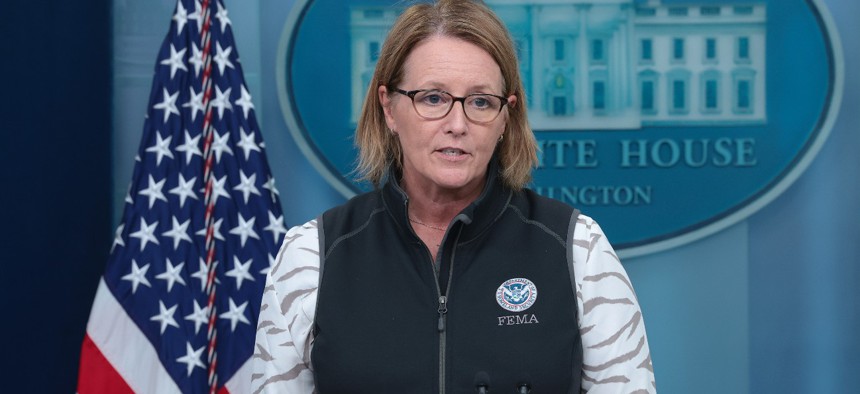
FEMA chief Deanne Criswell speaks during the daily press briefing at the White House on August 29. Criswell answered questions about preparations for Hurricane Idalia. Win McNamee / Getty Images
Feds pre-deploy to Florida in anticipation of major hurricane
FEMA looks to manage workforce shortages as it responds to multiple crises at once.
As the Biden administration continues to provide recovery services in Hawaii after devastating fires on Maui, it must now prepare for another potential disaster: a storm heading for Florida’s Gulf Coast region.
Hurricane Idalia is expected to make landfall in the state’s Big Bend area—the northwestern coast south of Tallahassee—with impacts ranging as far south as Tampa. A dozen coastal counties have issued mandatory evacuation orders and the federal government is already preparing to assist in local recovery efforts.
The Federal Emergency Management Agency has sent 640 personnel to the area who are “prepared to respond if requested to do so,” the White House said on Tuesday. It has deployed six Incident Management Assistance Teams, nine Urban Search and Rescue Teams and three Disaster Survivor Assistance Strike Teams. The Army Corps of Engineers has a team to fill shelter, food and energy needs, in conjunction with the American Red Cross.
FEMA noted its warehouse in Atlanta is fully stocked and the agency is ready to transfer goods to Florida as needed. It has a Staging Management Team at Maxwell Air Force Base waiting to assist. State and federal officials stressed the Biden and Gov. Ron DeSantis administrations have worked together without issue and the two leaders were in communication on Tuesday. DeSantis also spoke to FEMA Administrator Deanne Criswell ahead of the storm and Biden has already declared an emergency to ease the distribution of resources.
Criswell said on Tuesday FEMA has hundreds of staff at its National Response Coordination Center in Washington to support any requests for federal assistance. She added that in addition to FEMA and Army Corps of Engineers personnel, Health and Human Services Department staff are in the area helping hospitals conduct evacuations.
Local governments have set up shelters throughout the region, schools and airports have closed and cities braced for flooding. As of Tuesday afternoon, storm surges already began to hit the area. FEMA noted it is prepared to assist in Georgia and South Carolina as well, which both currently stand in Idalia’s path.
In Maui, meanwhile, about 830 federal personnel remain on the ground conducting various relief and recovery efforts. That is down from the peak of more than 1,000 federal responders on the island last week. FEMA staff are helping impacted residents register for assistance, while employees from several other agencies are providing additional support. President Biden, who recently visited Maui, has repeatedly pledged the federal government will stay in Maui as long as it takes to help the community there rebuild.
By its own admission, FEMA is struggling to maintain its workforce as unprecedented demands have caused burnout and turnover to spike. The agency’s disaster response workforce has dipped by more than 20% since 2020, according to a recent Government Accountability Office report. Its cadre of public assistance staff went from 100% capacity before the pandemic to just 55% in the years that followed the outbreak, in part due to attrition and in part because the need grew by 130%.
FEMA is looking to grow its workforce by the equivalent of nearly 1,500 full-time employees in fiscal 2024—a figure that includes both its regular, permanent staff and its corps of reservists. Combined with the 1,200 it planned to add in the current fiscal year, FEMA is aiming for a 20% surge in its staffing levels from the end of September 2022.
In the 1960s, the United States declared an average of 18 major disasters per year. FEMA responded to 104 such disasters in 2020 and 58 in 2021. FEMA’s cadre of reservists have been stretched thin in recent years, as they deployed to not just hurricane and wildfire response but also pandemic, border and Afghan evacuee obligations. The agency is also considering its role in responding to extreme heat. FEMA employees previously sounded the alarm on their lack of down time between assignments, despite efforts in recent years to give them more time before redeploying.
"I know it hasn't been very long since I have been up here briefing all of you," Criswell said at the White House on Tuesday, "but I think that this really is indicative of the pace of the major disasters that we are seeing across the nation." She added if FEMA requires more personnel, it can pull individuals currently working on other open disasters or activate the Surge Capacity Force to brining employees from other parts of the Homeland Security Department.
FEMA must also deal with the compounding financial strain being placed on it by the simultaneous disasters. The White House recently asked for $12 billion for FEMA to refill the coffers for disaster response and officials have indicated that total may not end up being sufficient. Congress, currently on recess, has yet to take up the matter, but leaders are hoping to attach the emergency spending to a stopgap funding bill before the end of September. The disaster fund is currently down to $3.4 billion as of Tuesday, Criswell said, forcing the agency to prioritize funding for Idalia, the Maui fires and future storms.







